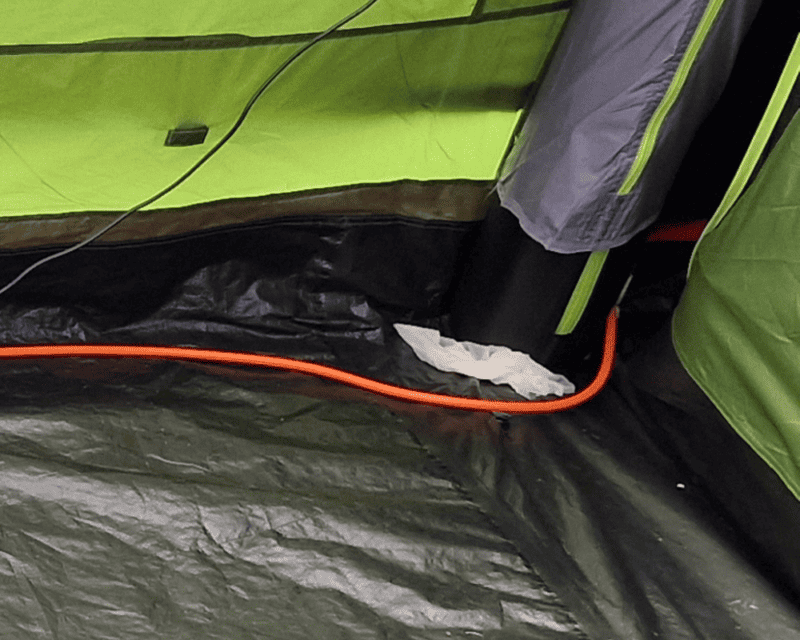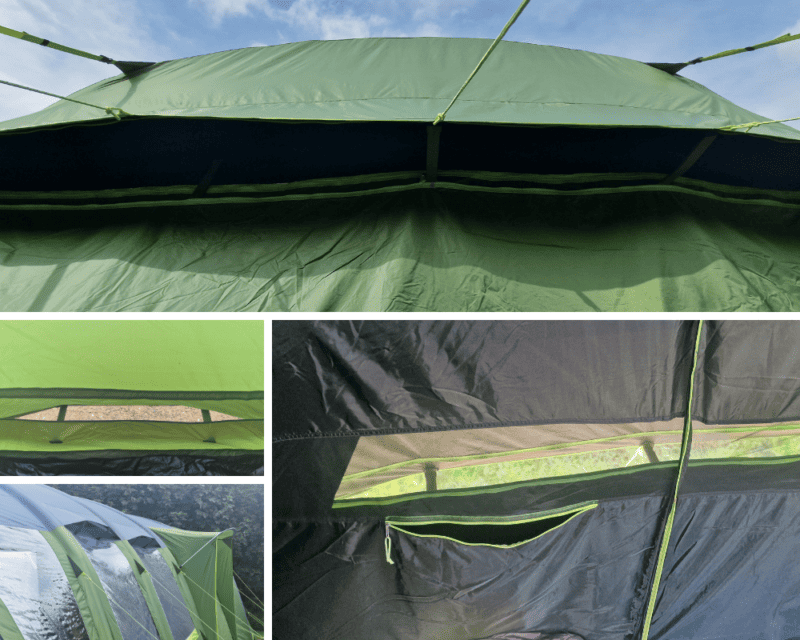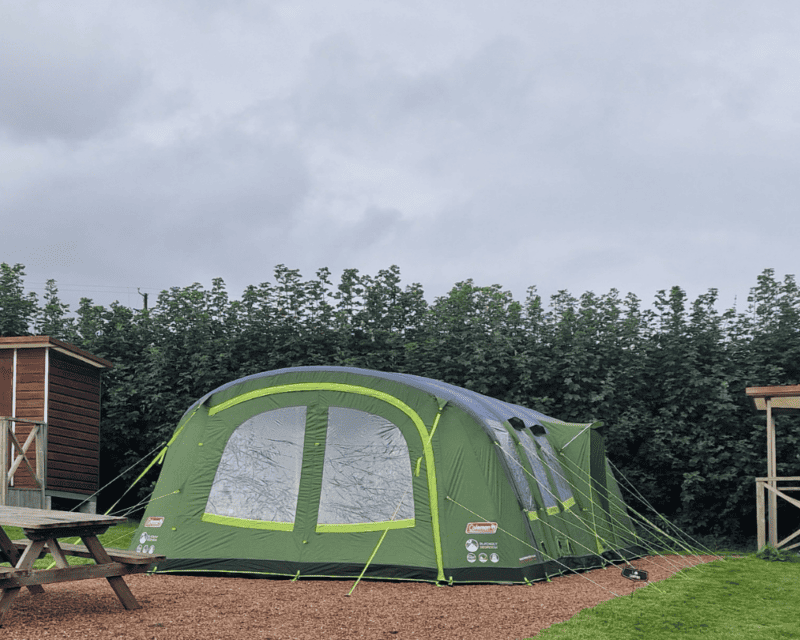When embarking on a camping adventure, your choice of shelter is crucial in ensuring a comfortable and dry experience. There’s nothing worse than waking up on the campsite to find water inside your tent, but how do you know whether condensation is to blame or if you have a leaking tent?
In this article, we’ll delve into the differences between these issues in my tent of choice, a Weathermaster 8XL air poled tent. Air poled tents offer convenience and ease of setup. However, I’ve noticed that they behave slightly differently to traditional, fibreglass poled tents. So, I want to share the insight I’ve gained to help make your camping trips enjoyable and hassle-free.
What is Condensation?

Condensation can be created in several ways, from the breath we exhale, wet clothes or even damp pets. The air inside the tent will hold this moisture, and if it is warmer than the air outside, it creates condensation when it hits the flysheet fabric.

This can also apply to cold air in the air poles and warm air in the tent. The result would be condensation running down the air poles and pooling at the bottom of the floor – leading some people to think their tent is leaking.
This is especially common during colder nights or when camping in areas with high humidity. Condensation can appear on the tent’s inner walls, roof, and even your gear.
Identifying Condensation
Condensation manifests as water droplets on the tent’s interior surfaces. It might give the appearance of a leak, but the key difference is that condensation usually occurs evenly across the tent’s surfaces. The droplets will not be localized to specific areas, and they won’t necessarily be associated with seams or zippers.
Many new tents have waterproofing finishes and systems to ensure that any rain stays on the outside and is swiftly conducted away without entering the tent. Occasionally, you may find water in your tent; this water is more likely to result from condensation than a leaking flysheet.
Why do air pole tents sometimes have puddles of water at the base of the poles?
Warm, wet air will not only condense on the inside of the tent flysheet, but it will also form on the inner-facing fabric of the air poles. Because the air poles are pressurised, they push down onto the groundsheet, creating a dip. The condensation will travel down the poles and sometimes collect in these hollows at the pole bases, causing the water to pool.
Preventing and Managing Condensation
Ventilation

Airflow is key to preventing condensation. Tents should have enough ventilation to allow air to pass through the tent and draw the warm, moisture-laden air out of the structure. For example, the Coleman Weathermaster Air tent range features both high and low ventilation panels throughout the tent. As well as full-width ventilation across the rear of the tent to allow air to flow through from the front to the rear bedroom area.
Pitch Selection
When it comes to preventing and managing condensation in your air poled tent, pitch selection plays a crucial role. The location where you choose to pitch your tent can determine how much condensation builds up inside. Avoid pitching your tent in low-lying areas or near water sources, as these places tend to have higher humidity levels. Instead, opt for higher ground that allows for better air circulation and drainage.
Use of Rainflies
Choosing a tent with a rainfly is an absolute game-changer for any camping adventure. Not only does it protect you from the unpredictable weather elements, but it also creates an additional layer of comfort and insulation. The rainfly protects against rain, snow, and even wind, ensuring you stay dry and cosy throughout your trip.
One of the main advantages of double-layered tents with rainflies is the barrier they create between you and the outdoors. This barrier of air helps to regulate the temperature inside the tent, keeping it cooler on hot days and warmer during chilly nights. It acts as insulation by trapping warm air between the layers, preventing heat loss and minimizing condensation buildup on the inner walls of the tent.
One often overlooked aspect of setting up an air poled tent is ensuring the rainfly and inner tent do not touch. When the rainfly and inner tent touch, moisture can transfer between the two layers. This can lead to moisture forming inside the tent. By fully pegging out your tent, you create space between these two layers, allowing for proper ventilation and airflow reducing condensation buildup.
Dehumidifying Packs

Consider using moisture-absorbing packs inside the tent to help reduce excess humidity. This was the result of ours after ten days camping in Devon in mostly dry weather. These packs are inexpensive to buy but helped to keep our tent dry. We bought these from Amazon for £9.97 for a box of 6 dehumidifier packs.
Leaking Air Poled Tents
On the other hand, a leaking air poled tent is a situation where water enters the tent due to compromised seams, zippers, or other areas where wear and tear have caused the waterproofing to become compromised.
Identifying Leaks
Leaks are often localised to specific areas, such as seams, zippers, or damaged fabric. You might notice water pooling in certain spots or consistent dampness in a particular tent area.
Preventing and Addressing Leaks
Quality Tent Selection

Invest in a high-quality air-beam tent like the Coleman Weathermaster from a reputable brand known for its durable and waterproof designs.
Proper Setup
During tent setup, ensure all seams are still in good condition and do not need re-sealing, and zippers are closed securely. The tent also needs to be secured so the fabric doesn’t sag, as this can hold onto water for longer.
Regular Maintenance
Inspect your tent before each camping trip, checking for signs of wear and tear, such as frayed seams or damaged zippers.
Emergency Repair Kit
Carry a tent repair kit that includes waterproof tape and sealant, which can be used for quick fixes in case of unexpected leaks.
Conclusion
When it’s time to pack your tent away, always ensure that it is fully dry. Any moisture can cause the growth of unpleasant mould and odours – nobody wants to camp in a smelly tent! Remember, a little knowledge goes a long way in ensuring your outdoor adventures remain enjoyable and stress-free.
